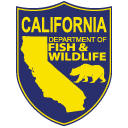Located on the northern California coast just south of the town of Mendocino, Van Damme State Marine Conservation Area (SMCA) encompasses a small, protected bay sheltered from north winds and large ocean swell. The bay is popular with freedivers, kayakers, scuba divers, and recreational anglers.

(click to enlarge) graphic by CDFW GIS Lab
For divers, venturing below the surface at Van Damme SMCA provides the opportunity to explore different habitat types, including soft bottom, rocky reef, and kelp forest. Divers are likely to encounter bat stars, leather stars, rock crabs, sea cucumbers, anemones and various species of abalone. If you’re lucky, a curious harbor seal might come and say hello!
Van Damme SMCA is also an ideal site for scientific monitoring. As a citizen scientific diver with Reef Check California, I spent a few months completing scientific diver training at the SMCA, learning how to use underwater tools to record information about the rocky reef and kelp forest habitats in the marine protected area (MPA).

Why protect kelp?

While Van Damme SMCA allows most types of recreational and commercial fishing, it prohibits the commercial take of bull kelp (Nereocystis luetkeana) and giant kelp (Macrocystis pyrifera). These two kelp species have unique structures called holdfasts, which look like the roots of land-based plants, and anchor the kelp to the rocky sea floor. Bull kelp have a single gas-filled bladder, which biologists call a pneumatocyst (pronounced “new-MAT-o-sist”), attached at the top of one long, stem-like stipe. The buoyant pneumatocyst holds the kelp upright in the water column. Large, leaf-like blades grow from the pneumatocyst and float on the surface of the ocean, forming a dense kelp forest canopy. Bull kelp have one stipe and one pneumatocyst, while giant kelp usually have many stipes and pneumatocysts coming from a single holdfast.
Healthy kelp forests are teeming with life. These submerged “jungles” offer sustenance and protective shelter for many marine species. Sea stars, snails, crabs, fish, anemones, sponges, tunicates and many other animals live at varying depths within a mature kelp forest habitat, hiding from predators and seeking plentiful foraging opportunities.
Kelp monitoring

The California Department of Fish and Wildlife conducts aerial surveys of the ocean’s surface annually to monitor California’s kelp forests. These surveys record the area of kelp forest canopy cover between the U.S.- Mexico border and the California-Oregon border. Since kelp monitoring began in 1989, Northern California’s kelp forests, including those at Van Damme SMCA, have declined dramatically, reaching their lowest levels from 2014 to 2016.
The reduction of kelp forest habitat in northern California can be attributed to many large-scale ecological changes, some of which may be due to human influence. Overall, the decrease in kelp forests has adversely affected species diversity as well as the valuable recreational abalone and commercial sea urchin fisheries in the area. Many marine species, including sea urchins and abalone, compete for kelp as a food source and can struggle in its absence.
Citizen science and scientific diving
In addition to the aerial surveys of kelp conducted by the California Department of Fish and Wildlife, Van Damme SMCA is also one of fourteen sites north of Point Arena monitored by Reef Check California. Beginning in 2007, the group has coordinated biannual underwater surveys of Van Damme SMCA using trained citizens as scientific scuba divers. Dive surveys collect data on algae, invertebrates, fish, and bottom type. The data collected is being used to help establish a baseline, or “point in time”, to compare against future measurements, which in turn can inform management and policy decisions within MPAs.

© Angela Edmunds, all rights reserved
For citizen scientific divers like myself, participating in hands-on monitoring of our MPAs is a meaningful use of a unique skill set. Through citizen science, community members can gain a deeper understanding of the local marine environment, and make a valuable contribution to the study of these complex ecosystems.
Through the years, Van Damme SMCA has remained one of my favorite locations to visit and dive. Watching the ebb and flow of kelp and other species has been an invaluable learning experience. The MPA’s ecosystem is intricately tied to the shared ocean heritage of the area for divers, anglers, beachgoers and ocean lovers alike.
Whether you enjoy participating in citizen science, diving, beachcombing, kayaking, or wildlife viewing, Van Damme SMCA is a north coast gem just waiting to be discovered and enjoyed.
Van Damme State Marine Conservation Area is one of the 124 MPAs in California’s statewide MPA Network. Please visit CDFW’s MPA website for more information, and sign up to receive updates about the MPA Management Program.
 post by Angela Edmunds, CDFW Scientific Aid
post by Angela Edmunds, CDFW Scientific Aid
Learn more about MPAs by diving into the
Exploring California’s Marine Protected Areas series!

